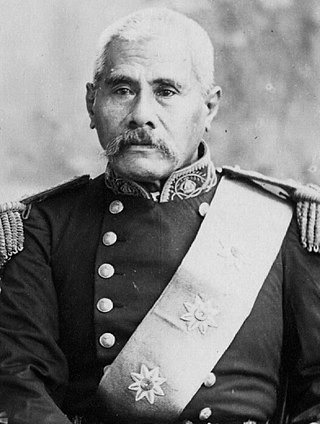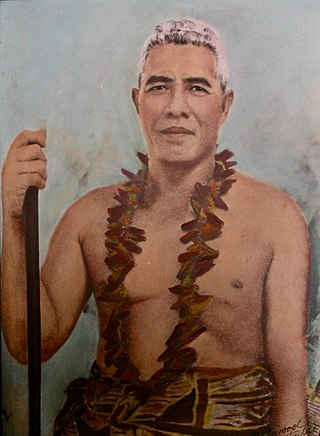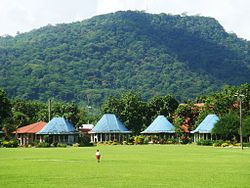
The Samoan Islands were first settled some 3,500 years ago as part of the Austronesian expansion. Both Samoa's early history and its more recent history are strongly connected to the histories of Tonga and Fiji, nearby islands with which Samoa has long had genealogical links as well as shared cultural traditions.

Politics of Samoa takes place in a framework of a parliamentary representative democratic state whereby the Prime Minister of Samoa is the head of government. Existing alongside the country's Western-styled political system is the fa'amatai chiefly system of socio-political governance and organisation, central to understanding Samoa's political system.
The Mau was a non-violent movement for Samoan independence from colonial rule during the first half of the 20th century. Mau means ‘resolute’ or ‘resolved’ in the sense of ‘opinion’, ‘unwavering’, ‘to be decided’, or ‘testimony’; also denoting ‘firm strength’ in Samoan. The motto for the Mau were the words Samoa mo Samoa. Similarly in Hawaiian Mau means to strive or persevere, and is often linked with Hawaiian poetry relating to independence and sovereignty struggles.

AfiogaFiamē Naomi Mataʻafa is a Samoan politician and High Chief (matai) who has served as the seventh Prime Minister of Samoa and leader of the Faʻatuatua i le Atua Samoa ua Tasi (FAST) party since 2021.
Le Mamea Matatumua Ata was one of the framers of the Constitution of Samoa. He held senior positions under the German colonial government of Samoa, New Zealand Trusteeship of Samoa and in the Independent State of Samoa.

Fiamē Mataʻafa Faumuina Mulinuʻu II was a Western Samoan paramount chief and politician. The holder of the Mataʻafa title, one of the four main Samoan chieftainships, he became the first prime minister of Western Samoa in 1959, serving until 1970. He held the position again from 1973 until his death in 1975.

Masiofo Laʻulu Fetauimalemau Mataʻafa, also known as Fetaui Mataʻafa, was a Samoan politician, chieftain and diplomat who served as a member of parliament for Lotofaga from 1975 to 1976, and again from 1979 to 1982. Mata'afa was later Samoa's first high commissioner to New Zealand. She was also the wife of Samoa's first Prime Minister, Fiame Mata'afa Faumuina Mulinu'u II. Their daughter, Fiamē Naomi Mataʻafa, is a matai high chieftess and former Cabinet Minister, former Deputy Prime Minister and current Prime Minister of Samoa. The honorific title "Masiofo" is the queenly title for the wife of a paramount chief in Samoa.

Samoa is made up of eleven itūmālō. These are the traditional eleven districts that were established well before European arrival. Each district has its own constitutional foundation (faavae) based on the traditional order of title precedence found in each district's faalupega.
Matatumua Maimoana (1935–2012), also known as Matatumua Maimoaga Vermeulen, was a matai, politician, Nurse and Environmentalist of Samoa. Her chief title, Matatumua, was an orator's title from the village of Faleasiu. She was a former member of parliament in Samoa and the founder of the Samoa All People's Party (SAPP), becoming the first woman to lead a political party in the country. SAPP allowed people as young as 16, regardless of gender or whether they were matai to be officers in the organisation which included village branches. She was a founding member of the Human Rights Protection Party (HRPP), which has dominated Samoan politics in the last two decades.

Susuga Malietoa Laupepa was the ruler (Malietoa) of Samoa in the late 19th century. He was first crowned in 1875.

The prime minister of the Independent State of Samoa is the head of government of Samoa. The prime minister is a member of the Legislative Assembly, and is appointed by the O le Ao o le Malo for a five-year term. Since independence in 1962, a total of seven individuals have served as prime minister. The incumbent was disputed due to the 2021 constitutional crisis, when Tuila'epa Sa'ilele Malielegaoi refused to accept the results of the 2021 general election. On 23 July 2021, the Samoan Court of Appeal ruled that the Faʻatuatua i le Atua Samoa ua Tasi (FAST) party had been in government since 24 May. Tuila'epa then conceded defeat, resulting in FAST party leader Fiamē Naomi Mataʻafa becoming prime minister.

Susuga Malietoa Tanumafili I was the Malietoa in Samoa from 1898 until his death in 1939. After the death of his father, Malietoa Laupepa, the recognized King of Samoa by many western countries, Tanumafili was immediately crowned as King, alongside Tupua Tamasese Lealofi I as vice-king. Tanumafili was backed by the United States and United Kingdom, however Germany supported rebel chief Mata'afa Iosefo who eyeing the throne. The battle between the two made up the Second Samoan Civil War and in the end caused the Tripartite Convention that split the islands. After the war, Malietoa pursued education in Fiji and then came back to Samoa, where he was appointed as an advisor.

Lotofaga is a village on the south coast of Upolu island in Samoa. Lotofaga is also the name of the larger Lotofaga Electoral Constituency which includes Lotofaga village and two other villages, Vavau and Matatufu. The population of Lotofaga village is 971.

Fa'amatai is the indigenous political ('chiefly') system of Samoa, central to the organization of Samoan society. It is the traditional indigenous form of governance in both Samoas, comprising American Samoa and the Independent State of Samoa. The term comprises the prefix fa'a and the word matai.

Mata'afa Faumuina Fiame Mulinu'u I was a high chief of Samoa and a leader of the country's pro-independence Mau movement during the 1920's and 1930's. He was the holder of high-ranking ali'i chiefly titles: the Tama-a-'aiga Mata'afa, Fiame from Lotofaga and Faumuina from Lepea.

Matāʻafa is one of the four paramount tama-a-ʻaiga titles of Samoa. It is one of two such titles originating from the Atua district at the east end of Upolu island and has its historical seat in the village of Amaile. Prominent holders of the title include Matā'afa Iosefo of Falefa, one of the three rival candidates for the kingship of Samoa during the early colonial period, Matāʻafa Faumuina Fiame Mulinuʻu I of Lepea and Lotofaga, who became leader of Samoa's pro-independence Mau movement after Tupua Tamasese Lealofi III's assassination; and his son Fiame Matāʻafa Faumuina Mulinuʻu II (1921–1975), the first Prime Minister of Samoa.

General elections were held in Western Samoa on 25 February 1967. All candidates ran as independents and voting was restricted to Matai and citizens of European origin, with the Matai electing 45 MPs and Europeans two. Following the election, Fiame Mata'afa Faumuina Mulinu'u II remained Prime Minister.

General elections were held in Western Samoa on 28 April 1948, the first to the new Legislative Assembly. The United Citizens Party won four of the five directly-elected seats.

General elections were held in Western Samoa on 15 November 1957.

Anapu Solofa was a Western Samoan chief and politician. He served as a member of the Legislative Assembly and as Minister of Justice.
















